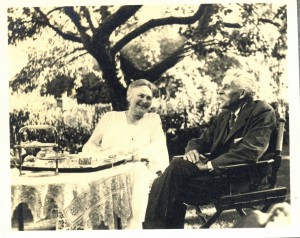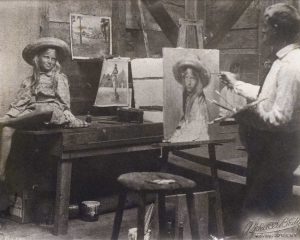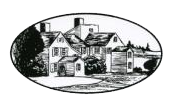
The Wentworth-Coolidge Commission’s commitment to the arts honors the artistic patrimony of one of the long-time owners of the Mansion, John Templeman Coolidge (1856 – 1945) and his two wives (Katherine Parkman m. 1879, d. 1900, and Abigail Parsons m. 1913 d. 1954). Under the Coolidge family’s 1886-1954 ownership, the Wentworth-Coolidge Mansion became a summertime center for Boston artists, and a summertime community developed around it. In the tradition of the Coolidge family, our annual exhibitions celebrate the works of living artists. Exhibitions at the Mansion are meant to help keep alive the idea of Portsmouth, the Seacoast and New England as centers of visual arts’ innovation and production.
Who was John Templeman Coolidge?
John Templeman Coolidge was a member of one of America’s oldest families, and independently wealthy thanks to the exertions of his forebears. A native of Boston, Templeman graduated from Harvard, Class of 1879, and was the first in his class to marry – to Katherine Parkman, daughter of the American historian Francis Parkman. Following the wedding the Parkmans spent the years 1879-1884/5 in Paris, where Templeman studied art in the atelier of J. Carolus Duran. Returning to Boston, the Coolidges purchased the Wentworth Coolidge Mansion and fifteen acres for the very reasonable price of $5,000, as a summer retreat from the city. Accessible by boat and by rail from Boston, both Portsmouth and the Wentworth Coolidge Mansion had seen better economic times, and Mr. and Mrs. Coolidge set about working on their property, and to encouraging Boston friends and acquaintances to join them. A summer community began to form[1] thanks to their efforts. Friends built or bought summer homes nearby, and artist friends from Boston were encouraged to come for a visit.
 What was “special” about the Post-Civil War New England Seacoast?
What was “special” about the Post-Civil War New England Seacoast?
The times were propitious for the growth of summer communities near Boston. The Boston leadership in the wake of the Civil War had transformed “from an elite to a social class whose members had abdicated a political role, and parlayed the economic success of their ancestors into building non-profit organizations that defined appropriate taste and educated others….They were not manufacturing, railroad or financial entrepreneurs but rather cultural capitalists, linked by common backgrounds, Harvard educations, intermarriage, and board memberships….To counter what they viewed as popular vulgarities, these Boston Brahmins built institutions that defined culture and set the parameters of public discussion about such art. The value put on culture – and control of culture – and the social distinction between mind and muscle provided the defining framework for Boston’s acceptance and adaptation of Arts and Crafts principles.”[2]
What was “special” about Post-Civil War Boston?
Boston’s post- Civil War wealth led to a substantial remaking of the city, including at least the following: formation of the Boston Society of Architects (1867); the formation of the Museum of Fine Arts, by the Boston Athenaeum, Harvard College and M.I.T. (1870); formation of the Boston Museum School (1876); the donation of Japanese traditional arts and crafts collections to the Museum of Fine Arts by Dr. William S. Bigelow and Dr. Charles Goddard Weld, aided by Ernest F. Fenellosa (1878); the founding of the Boston Symphony, by Major Henry Lee Higginson (1881; Higginson funded the Symphony until his death); Mr. and Mrs. John Lowell (Isabella Stuart) Gardner visit Japan with Dr. William Sturgis Bigelow ; returning from Japan Mrs. Gardner begins to collect Renaissance art 1883/4); construction of the Boston Public Library, architects McKim, Mead & White (1887-1895); Mrs. Gardner purchases land and builds Fenway Court, her Boston home ( 1899,completed 1902/03);Boston architects Cram, Wentworth & Goodhue get Museum of Fine Arts contract to build new Japanese galleries and a Japanese garden (1909).[3]
An Appreciation
John Templeman Coolidge was a long-time trustee of the Boston Museum of Fine Arts, and a highly trained, competent and capable artist. A number of his oil on canvas paintings, and those of other Coolidge family members, are on display here. One of Templeman’s historical dioramas, formerly on display at the Boston Museum of Fine Arts, has been released to the Wentworth Coolidge Mansion by the Museum; it may be seen in its standing case on the first floor of the Mansion. In addition Mr. and Mrs. Coolidge underwrote much of the production of the Dedham (MA) Art Pottery, as well as anonymously supporting the artistic productions of numerous other artists. The Wentworth-Coolidge Commission Inc. is honored to mount its annual exhibitions in memory of the generosity of Mr. and Mrs. John Templeman Coolidge and the Coolidge family to help ensure the ongoing vitality of the visual arts.
History written by Wentworth-Coolidge Commissioner Russell Bastedo
For those interested in learning more about the Coolidge Era, we suggest the following:
William Leach, Land of Desire: Merchants, Power and the Rise of a New American Culture (Pantheon, 1993);
Roberta Sheehan, The Boston Museum School: A Centennial History, 1876-1976. (Boston College PhD. Thesis, 1983);
Janet Karden ed., The Ideal Home, 1900-1920: The History of 20th Century American Craft (Abrams, 1993);
David McCullough, The Greater Journey (2011).
[1] Woodward Openo, “The Summer Colony at Little Harbor, Portsmouth, New Hampshire and its Place in the Colonial Revival Movement.” (unpublished PhD. Thesis)
[2] Edward S. Cooke, Jr., “Talking or Working: The Conundrum of Moral Aesthetics in Boston’s Arts and crafts Movement”; in Mailee Boyd Meyer, ed., Inspiring Reform: Boston’s Arts and Crafts Movement (Davis Museum and Cultural Center, 1997), p. 19ff.
[3] Walter Muir Whitehill, “Boston Artists and Craftsmen at the Opening of the Twentieth Century” [New England Quarterly, vol. 50 no. 3 (September 1977).
